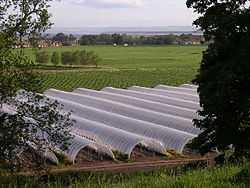Polytunnel

A polytunnel (also known as a polyhouse, hoop greenhouse or hoophouse, or high tunnel) is a tunnel made of polyethylene, usually semi-circular, square or elongated in shape. The interior heats up because incoming solar radiation from the sun warms plants, soil, and other things inside the building faster than heat can escape the structure. Air warmed by the heat from hot interior surfaces is retained in the building by the roof and wall. Temperature, humidity and ventilation can be controlled by equipment fixed in the polytunnel.
Uses
Polytunnels can be used to provide a higher temperature and/or humidity than that which is available in the environment but can also protect crops from intense heat, bright sunlight, strong winds, hailstones and cold waves. This allows fruits and vegetables to be grown at times usually considered off season. Every factor influencing a crop can be controlled in a polytunnel. Polytunnels are often used in floriculture and nurseries as the economic value of flowers can justify their expense.
Temperate regions
Polytunnels are mainly used in temperate regions in similar ways to greenhouses and cloches (row covers). Modern designs allow sowing and harvesting machines to move inside the structures so as to automate production. Polytunnels have had a significant effect on the production of strawberries in the United Kingdom. Other soft fruits such as raspberries and blackberries are also cultivated in the same way.
Other regions

High tech poly houses even have heating systems as well as soil heating systems to purify the soil of unwanted viruses, bacteria etc.The recent Indo-Israel collaboration at Gharunda, near Karnal is an excellent example of Polyhouse farming taking place in a developing country.
In India, the inability to grow tomato during rainy season allows its price to soar during the monsoon. This is spotted as an ideal time to grow tomato in polytunnels providing the ideal climate for the crop. In India, Abhinav Farmers Club grows flowers and organic vegetables in polytunnels.[1]
Development
A US Department of Agriculture program is helping farmers install polytunnels. The program was announced at the US White House garden in December, 2009.[2]
Farmers in Iraq are building these in increasing number and adding drip irrigation to grow tomatoes.[3]
References
Notes
- ↑ Bhattacharyya, Pramit (2012-05-17). "Planting the seeds of prosperity". Live Mint and The Wall Street Journal (New Delhi). Retrieved 23 November 2012.
- ↑ USDA TO LAUNCH HIGH TUNNEL PILOT STUDY TO INCREASE AVAILABILITY OF LOCALLY GROWN FOODS. Retrieved from http://www.usda.gov/wps/portal/!ut/p/_s.7_0_A/7_0_1OB?contentidonly=true&contentid=2009/12/0617.xml
- ↑ Tharp, M. (2009, July 17). Once world's bread basket, Iraq now a farming basket case. McClatchy Newspapers. Retrieved from http://news.yahoo.com/s/mcclatchy/20090717/wl_mcclatchy/3274217
Video
- USDA Promotes Hoop Houses at White House Garden Event Intro - http://www.youtube.com/watch?v=14jE1T2Vd_Q
- "Quick Garden Hoop" The Martha Stewart Show (February 18, 2010) - http://www.marthastewart.com/article/quick-hoop
- Polytunnel Construction Videos - http://www.youtube.com/user/polytunnels
External links
- First Tunnels - UK Company Specialising in Polytunnels